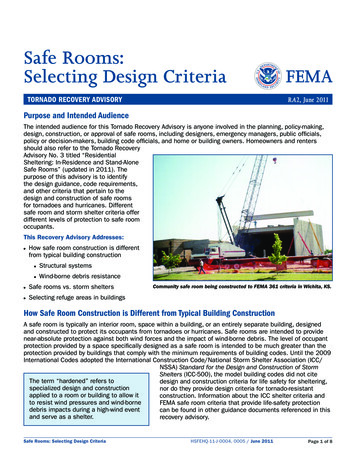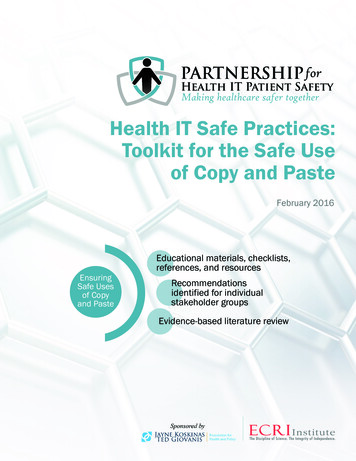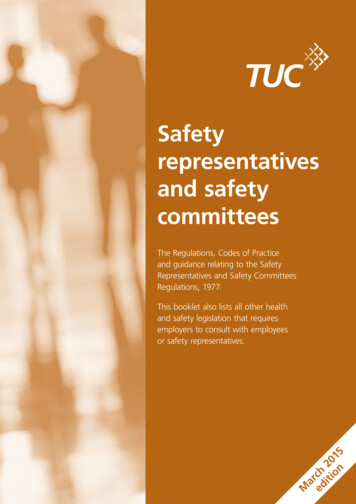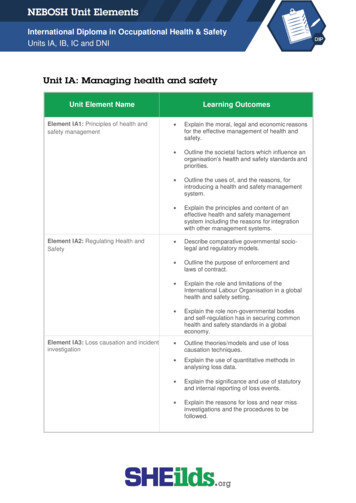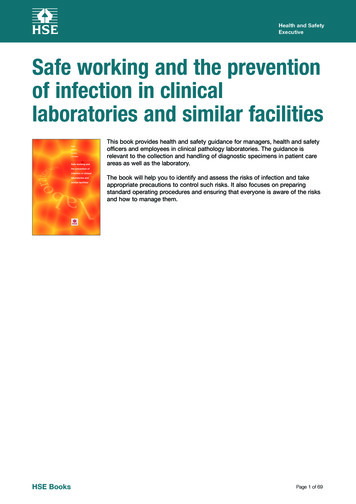
Transcription
Health and SafetyExecutiveSafe working and the preventionof infection in clinicallaboratories and similar facilitiesThis book provides health and safety guidance for managers, health and safetyofficers and employees in clinical pathology laboratories. The guidance isrelevant to the collection and handling of diagnostic specimens in patient careareas as well as the laboratory.The book will help you to identify and assess the risks of infection and takeappropriate precautions to control such risks. It also focuses on preparingstandard operating procedures and ensuring that everyone is aware of the risksand how to manage them.HSE BooksPage 1 of 69
Health and SafetyExecutive Crown copyright 2003First published 1991ISBN 978 0 7176 2513 0All rights reserved. No part of this publication may be reproduced, stored ina retrieval system, or transmitted in any form or by any means (electronic,mechanical, photocopying, recording or otherwise) without the prior writtenpermission of the copyright owner.Applications for reproduction should be made in writing to:The Office of Public Sector Information, Information Policy Team,Kew, Richmond, Surrey TW9 4DU or e-mail: licensing@opsi.gov.ukThis guidance is issued by the Health and Safety Executive. Following the guidanceis not compulsory and you are free to take other action. But if you do follow theguidance you will normally be doing enough to comply with the law. Health andsafety inspectors seek to secure compliance with the law and may refer to thisguidance as illustrating good practice.Page 2 of 69
Health and SafetyExecutiveContentsIntroduction 6Health and Safety Law 7Health and Safety at Work etc Act 1974 7Management of Health and Safety at Work Regulations 1999 7Control of Substances Hazardous to Health Regulations 2002 8Reporting of Injuries, Diseases and Dangerous Occurrences Regulations 1995 8Consulting employees 9Duties to non-employees 9Lone workers 10Health and Safety Management 10Roles and responsibilities 10Supervision 10Laboratory safety officers 11Health and safety arrangements 11Risk assessment 12Categorisation of biological agents 13Containment levels 14Buildings and accommodation 16Security and access 17Heating, lighting and ventilation 17Fittings and furniture 17Floors 18Staff welfare facilities 18Standard operating procedures and safe working practices 18Standard operating procedures 18Provision and use of personal protective equipment (PPE) 19Personal hygiene 20Risks and prevention of blood-borne infections 21Handling specimens and biological agents 22Stock cultures 22Ampoules 23Media preparation 23Plating out 23Handling unfixed specimens for slide preparation 24Electron microscopy 24Sharps 25Action after sharps injury or contamination with blood or other body fluids 25Equipment 26Automated laboratory equipment 26Non-infection risks associated with equipment 26Homogenisers and shakers 27Cryostats 27Centrifuges 27Microbiological safety cabinets 29Laboratory autoclaves 31Review and revise practices and procedures 34Safe working and the prevention of infection in clinical laboratories and similar facilitiesPage 3 of 69
Health and SafetyExecutiveLabelling, transport and reception of specimens 35Information 35Transport 35Reception of specimens at the laboratory 37Cleaning, decontamination and waste disposal 38Cleaning and decontamination 38Disposal of laboratory waste 39Packaging sharps 40Information, instruction and training 40Staff training 40Health surveillance and immunisation 41Before employment 41On employment: immunisation 42During employment 42Medical contact cards 43Incidents and accidents 43Dealing with incidents and accidents 43Dealing with spillages 44Fires 45Measuring, auditing and reviewing performance 46Measuring performance 46Audit of performance 46Review of performance cal safety cabinets 47Disinfectants and disinfection in the clinical laboratory 52Packaging requirements for some diagnostic specimens 56Staff safety guidelines 57References 65Further information 69Safe working and the prevention of infection in clinical laboratories and similar facilitiesPage 4 of 69
Health and SafetyExecutiveOrganisations represented on the Health Services AdvisoryCommittee.Working Group MembersMs M BurrowsNorthampton Commissioning Primary Care Group(formerly, Oxford Radcliffe NHS Trust)Dr AC McCartneyCentral Public Health Laboratory, ColindaleMr S PhilipSt Mary’s NHS Trust, PaddingtonMr J RichardsUNISON Health CareDr T WyattMater Hospital NHS Trust, BelfastMr K AshleyHealth and Safety ExecutiveMr D HeadHealth and Safety ExecutiveMs J LopexHealth and Safety ExecutiveMs S WilliamsHealth and Safety ExecutiveConsulteesAdvisory Committee on Dangerous PathogensAIDS Education and Research TrustAssociation of British Health Care IndustriesAssociation of Clinical BiochemistsAssociation of Clinical PathologistsAssociation of Medical Research CharitiesAssociation of Medical MicrobiologistsBiotech Group, Chemical Industries AssociationBiotechnology and Biological Sciences Research CouncilBritish Occupational Hygiene SocietyBritish Society for HaematologyBritish Veterinary AssociationClinical Pathology Accreditation (UK) LtdConfederation of British IndustryDepartment of HealthGlaxo WellcomeHealth Services Advisory CommitteeHospital Infection SocietyInfection Control Nurses AssociationInstitute of Biomedical ScienceInstitution of Occupational Safety and HealthLondon School of Hygiene and Tropical MedicineMedical Devices AgencyMedical Research CouncilManufacturing Science FinanceNational Assembly for Wales - Public Health DivisionNational Institute for Biological Standards and ControlNational Institute for Medical ResearchNHS EstatesPathological Society of Great Britain and IrelandPublic Health Laboratory ServiceRoyal Society for the Prevention of AccidentsRoyal College of PathologistsRoyal College of Veterinary SurgeonsRoyal Institute of Public Health and HygieneScottish ExecutiveScottish Health Care SuppliesUniversity of BristolWillis Scotland LtdSafe working and the prevention of infection in clinical laboratories and similar facilitiesPage 5 of 69
Health and SafetyExecutiveIntroduction1 This book provides guidance on health and safety for all those involved inwork in clinical pathology laboratories. It updates and replaces the Health ServicesAdvisory Committee (HSAC) publications Safe working and the prevention ofinfection in clinical laboratories and The guidelines for staff and visitors, bothpublished in 1991. This document develops the content of the two earlier booksby setting the guidance in the context of the requirements of the Management ofHealth and Safety at Work Regulations 1 and the Control of Substances Hazardousto Health Regulations.22 The guidance is relevant to work in hospitals and other facilities wherepeople may be exposed to biological agents, for example in universities, researchestablishments, primary care facilities and veterinary laboratories. It applies todiagnostic work in patient care areas, such as outpatients departments, intensivetherapy or neonatal units and to work by general practitioners at their surgeries.3 Advice is given for all parties involved in the management and operation ofclinical laboratories: employers and senior managers who have responsibilityfor setting policies and for ensuring that risks are assessed and eliminated orcontrolled; line managers, such as laboratory managers, who may be responsiblefor implementing policies and procedures; employees who work in clinicallaboratories; and others who can influence policies and good practice, suchas laboratory safety managers, risk managers, health and safety officers, andemployee safety representatives.4This guidance is intended to help these parties: identify and assess the risks of infection; take appropriate precautions to eliminate or control such risks; prepare standard operating procedures, setting out the precautions andarrangements for carrying out the work; ensure that everyone is aware of the risks and what to do about them; meet their duties under health and safety law.5 The guidance emphasises the need for employers and employees to worktogether to create an environment and culture in which safe practices andappropriate work procedures and policies are prepared, adopted, and reviewed.6 A separate HSAC publication deals with safe working and the prevention ofinfection in the post-mortem room and mortuary.37 The Advisory Committee on Dangerous Pathogens (ACDP) has also publishedguidance, The management, design and operation of microbiological containmentlaboratories,4 which expands on the legal requirements set out in the Control ofSubstances Hazardous to Health Regulations 2002,2 with a focus on the design,construction and operation of laboratories which are used for containment ofmicrobiological work at containment levels 2 and 3.8 The terms ‘should’ and ‘must’ are used throughout this document to conveyobligation. They are of equivalent meaning, and are used where the guidance offersa way of complying with a legal duty, as distinct from recommendations on whatconstitutes good practice.Safe working and the prevention of infection in clinical laboratories and similar facilitiesPage 6 of 69
Health and SafetyExecutiveHealth and safety lawHealth and Safety at Work etc Act 19749 The Health and Safety at Work Act 5 places general duties on employers,employees and others.Health and Safety at Work Act - key dutiesEmployers must: protect the health and safety of their employees; protect the health and safety of others who might be affected by the way theygo about their work (for example, cleaners, visitors or contractors working inthe laboratory); prepare a statement of safety policy and the organisation and arrangementsfor carrying it out (if 5 or more people are employed, this statement must bewritten down).Employees must: take care of their own health and safety and that of others; co-operate with their employer.Although only the courts can give an authoritative interpretation of the law, inconsidering the application of the Act and its regulations and guidance to peopleworking under another’s direction, the following should be considered:‘if people working under the control and direction of others are treated as selfemployed for tax and national insurance purposes they are nevertheless treatedas their employees for health and safety purposes. It may therefore be necessaryto take appropriate action to protect them. If any doubt exists about who isresponsible for the health and safety of a worker this could be clarified and includedin the terms of a contract. However, a legal duty under section 3 of the Health andSafety at Work Act 1974 (HSW Act) 5 cannot be passed on by means of a contractand there will still be duties towards others under section 3 of HSW Act.5 If suchworkers are employed on the basis that they are responsible for their own healthand safety, legal advice should be sought before doing so.’Management of Health and Safety at Work Regulations 199910 The general duties in the Health and Safety at Work Act are developed inthe Management of Health and Safety at Work Regulations (the ManagementRegulations) and other more specific pieces of law. The Approved Code of Practiceon the Management Regulations provides further guidance.111 The duty under the Management Regulations to co-operate and co-ordinatewith other employers and self-employed persons, is particularly pertinent inorganisations with increasing use of contractors, including private finance initiativeschemes and public/private partnerships.Safe working and the prevention of infection in clinical laboratories and similar facilitiesPage 7 of 69
Health and SafetyExecutiveThe Management Regulations - key dutiesEmployers must: assess risks to staff and others, including visitors, young persons and new andexpectant mothers; 6,7 make appropriate health and safety arrangements, which must be writtendown if five or more people are employed; appoint competent persons to help them comply with health and safety law; establish procedures to deal with imminent danger; co-operate and co-ordinate with other employers and self-employed personswho share the workplace.Employees must: work in accordance with training and instruction given by their employer; report situations which they believe to be unsafe.Control of Substances Hazardous to Health Regulations 200212 The Control of Substances Hazardous to Health Regulations (COSHH) 2 dealspecifically with risks from all hazardous substances including hazardous biologicalagents. Schedule 3 to the Regulations has special requirements for work withbiological agents. Appendix 2 of the COSHH Approved Code of Practice 2 givespractical guidance on the application of the Regulations.COSHH - key dutiesEmployers must: assess risks created by work with substances hazardous to health; ensure the selection and use of appropriate control measures, including theuse of the appropriate containment level(s) for the biological agents likely to beencountered; ensure the maintenance, examination and test of control measures, such asmicrobiological safety cabinets; keep lists of employees exposed to hazard group 3 and 4 biological agents for40 years; notify HSE of the intention to use or store for the first time, biological agents inhazard groups 2, 3 and 4 - and each subsequent use of a new biological agentspecified in Part V of Schedule 3; provide appropriate health surveillance of employees; provide information, instruction and training for employees about the risks andprecautions to be taken.Reporting of Injuries, Diseases and Dangerous OccurrencesRegulations 199513 The Reporting of Injuries, Diseases and Dangerous Occurrences Regulations(RIDDOR)8 require employers to report specified accidents, dangerous occurrencesand cases of ill health to HSE.Safe working and the prevention of infection in clinical laboratories and similar facilitiesPage 8 of 69
Health and SafetyExecutiveAccidents and dangerous occurrences relevant to clinical laboratorieswhich must be reported under RIDDOR include: any infection reliably attributable to work with micro-organisms; cases of specified infectious diseases such as hepatitis, tuberculosis; acute illness which requires medical treatment resulting from exposure to abiological agent or its toxins, or infected material; any incident which resulted in, or could have resulted in, the release or escapeof a biological agent likely to cause severe human infection or illness; loss of consciousness caused by exposure to a biological agent.The Reporting of Injuries, Diseases and Dangerous Occurrences Regulations1995: Guidance for employers in the healthcare sector provides further guidanceon RIDDOR for the healthcare sector.9Consulting employees14 Two pieces of health and safety law cover consultation with employees:the Safety Representatives and Safety Committees Regulations 1977 deal withconsulting recognised trade unions through their safety representatives andthe Health and Safety (Consultation with Employees) Regulations 1996 coveremployees who do not have trade union safety representatives. Detailed guidanceis provided in Safety representatives and safety committees and A guide to theHealth and Safety (Consultation with Employees) Regulations 1996. Guidance onRegulations.10,11Employers must consult employees and their representatives aboutaspects of their health and safety at work, including: any change which may substantially affect their health and safety;their employer’s arrangements for getting competent health and safety advice;the information provided on reducing and dealing with risks;the planning of health and safety training;the health and safety consequences of introducing new technology.Arrangements for dealing with infection risks in laboratories are only fully effectiveif employers closely involve employees and their representatives.Duties to non-employees15 Under the Health and Safety at Work Act 5, employers have general dutiestowards people who are not their employees, but who may be affected by theirwork activities. In a laboratory, these include cleaners, contract staff, patients andothers who are not at work.16 Contracts with any other employers who use the laboratory and with staffagencies need to take health and safety into account, so that everyone is clearabout their responsibilities. In some cases, employers may owe the same dutiestowards agency staff under health and safety law as they do towards their ownemployees.Safe working and the prevention of infection in clinical laboratories and similar facilitiesPage 9 of 69
Health and SafetyExecutive17 People employed by different organisations may share a workplace, oremployees of one organisation may work in an area controlled by another. Thisis common, for example, in a teaching hospital. In such cases, the employersinvolved must co-operate and co-ordinate their activities, to enable everyone tocomply with their legal duties. Employers need to ensure that everyone working inthe laboratory has sufficient information, instruction and training to work safely.Lone workers18 There may be situations where staff work alone in the laboratory, particularlyoutside normal working hours. Although there is no general legal prohibition onworking alone, the broad duties of the Health and Safety at Work Act and theManagement Regulations apply.19 Where lone working is foreseeable, a risk assessment should be made takinginto account the risks from exposure to biological agents and other risks present inthe laboratory. The risk assessment will need to determine whether the work canbe done safely by a lone worker, and any necessary special control measures.20 Procedures to ensure the continued safety of lone workers will need to beput into place. Systems should be set up to monitor lone workers to ensure theyremain safe. These may include periodic visits to the laboratory by supervisors andproviding means of raising the alarm in the event of an emergency. Working alonein safety: Controlling the risks of solitary work provides guidance on working alonesafely.12Health and safety managementRoles and responsibilities21 Legal responsibility for health and safety in the laboratory cannot be delegatedand rests primarily with the employer. This involves assessment of the risks,development of policies, putting arrangements in place to implement those policiesand monitoring the way those arrangements work, ie employers must makearrangements to manage health and safety.22 Effective management can only be achieved through involvement of the linemanagement chain. Action to ensure that adequate precautions are in place isgenerally delegated down to line managers. The heads of department have a keyrole in managing health and safety in laboratories.Supervision23 All laboratories need arrangements for supervising work, checking thathealth and safety measures remain effective and standard operating proceduresare observed. Effective management of health and safety is much more likely ifsenior managers give a clear lead and accept that it is an important part of theirfunction. Some departments may designate a laboratory safety officer to overseeand implement the health and safety arrangements, help ensure standards aremaintained and standard operating procedures observed.Safe working and the prevention of infection in clinical laboratories and similar facilitiesPage 10 of 69
Health and SafetyExecutiveLaboratory safety officers24 Laboratory safety officers can play an important role in the day-to-day runningof the laboratory, although responsibility for health and safety arrangements remainswith line managers and heads of department. Safety officers need to be known byall members of staff and regular visitors to the laboratory.25 Nominated safety officers need: appropriate training in health and safety matters; authority under the head of department to carry out their duties; sufficient time free from other commitments.26 The duties of nominated laboratory safety officers may include: providing adequate, supervised health and safety training for all new membersof staff in accordance with the standard operating procedures; regularly updating training programmes; preparing and introducing programmes for the training and familiarisation ofstaff with new work techniques; ensuring procedures for effective decontamination by disinfection or sterilisationare put into action; ensuring procedures for the safe collection and disposal of waste are followed; in consultation with others, preparing and regularly updating written instructionsfor safe working practices; ensuring that adequate supplies of protective clothing and safety equipment areavailable and kept in good working order; carrying out periodic inspections to detect and identify any unsafe workpractices or items of equipment; ensuring that all hazardous materials are labelled, handled, stored and disposedof safely; liaising with the occupational health service, risk managers, the fire preventionofficer, safety representatives and staff; ensuring that the work of staff and contractors, including those workingoutside normal hours, is properly supervised and arrangements are made for aresponsible person to be available at all times, in case of accidents; checking that visitors are accompanied by a member of staff, to advise themon the appropriate safety measures to be observed; participating in safety committee or other health and safety meetings.Health and safety arrangements27 The Health Services Advisory Committee (HSAC) has published Managementof health and safety in the health services: Information for directors and managerswhich details health and safety management in the health services.13 The elementsof this framework are referred to throughout this guidance and are shown inFigure 1.Safe working and the prevention of infection in clinical laboratories and similar facilitiesPage 11 of 69
Health and SafetyExecutivePolicyOrganisingAuditingPlanning manceFigure 1 Key elements of successful health and safety management28 Within this framework employers need to consider a number of key areasincluding: hazard group;risk assessment;containment levels;buildings and accommodation;standard operating procedures, including safe working practices;information, instruction and training;health surveillance;monitoring, audit, review.Risk assessment29 Risk assessment is not simply a paper exercise. Its purpose is to ensure thatthere are appropriate precautions in place. Risk assessment involves systematicallylooking at the work to see which biological agents may be present, identifyingthe significant risks and identifying the precautions needed to eliminate or controlthese risks. It can be simplified into a five-step process. Further guidance on theManagement Regulations and risk assessment is contained in Management ofHealth and Safety at Work Regulations 1999. Approved Code of Practice andguidance and Five steps to risk assessment.1,1430 The risk assessment process should be integrated within the overall frameworkof Governance in the National Health Services.Safe working and the prevention of infection in clinical laboratories and similar facilitiesPage 12 of 69
Health and SafetyExecutiveFive steps to risk assessment: Step one: look for hazards; Step two: identify who might be harmed and how; Step three: evaluate the risks - consider the existing controls and assess theextent of the risks which remain; Step four: record the findings of the assessment - including the controlsnecessary and any further action needed to reduce risk sufficiently; Step five: review, revise and modify the assessment - particularly if the natureof the work changes or if developments suggest that it may no longer be valid.31 In assessing infection risks, the key points to consider are: which hazardous biological agents may be present;the hazard groups to which they belong;their virulence, transmissibility, and route(s) of infection;the type of work being carried out;the likelihood of infection occurring (including during normal work and in theevent of an accident); the prevalence of particular infections in the local community; risks to laboratory staff and others such as visitors, cleaners, maintenance staff,contractors.32 Employers must assess the risks at all sites where diagnostic testing is carriedout, including hospital wards, clinics, health centres and surgeries. If the assessmentsshow that employers cannot adequately control the risk in some locations, theyshould either improve the arrangements or send the specimens elsewhere forprocessing. This may mean transferring some work to clinical laboratories.33 Risks of infection are not the only ones which employers need to assess whenlooking at laboratory work. Other risks may include the use of liquid nitrogen,chemicals, manual handling of loads, ionising radiation and fire hazards. Thehospital Radiation Protection Adviser should be consulted on how to work safelywith specimens containing radioactive material.Categorisation of biologicalagents34 COSHH 2 defines a biological agent as ‘any micro-organism, parasite,microscopic infectious form of larger parasite, cell culture, or human endoparasite,including any which have been genetically modified, which may cause any infection,allergy, toxicity or otherwise create a hazard to human health’.35 The Second supplement to: Categorisation of biological agents accordingto hazard and categories of containment 2000 15 contains an Approved List(Categorisation 2000) which assigns biological agents into their hazard group asapproved by the Health and Safety Commission (HSC). It contains the ExemptionCertificate for those hazard group 3 agents which are subject to derogation fromcontainment level 3 (see paragraph 39). The ACDP guidance, The management,design and operation of microbiological containment laboratories,4 details thecontainment levels appropriate for each hazard group. All employers whose workinvolves exposure of their employees to biological agents will need to refer to theACDP guidance and the second supplement, to be able to comply with COSHH.Safe working and the prevention of infection in clinical laboratories and similar facilitiesPage 13 of 69
Health and SafetyExecutiveCategorisation of biological agents - definitions of hazard groups hazard group 1: A biological agent unlikely to cause human disease. hazard group 2: A biological agent that can cause human disease and maybe a hazard to employees; it is unlikely to spread to the community and thereis usually effective prophylaxis or effective treatment available. hazard group 3: A biological agent that can cause severe human diseaseand presents a serious hazard to employees; it may present a risk of spreadingto the community, but there is usually effective prophylaxis or treatmentavailable. hazard group 4: A biological agent that causes severe human disease and isa serious hazard to employees; it is likely to spread to the community and thereis usually no effective prophylaxis or treatment.36 Anyone working with blood-borne viruses, transmissible spongiformencephalopathies and viral haemorrhagic fevers, should follow the ACDP’s specificguidance, Protection against blood-borne infections in the workplace: HIV andhepatitis, Transmissible spongiform encephalopathy agents: safe working andthe prevention of infection and Management and control of Viral Haemorrhagicfevers.16,17,1837 Cases of hazard group 4 infection are rare in this country. However, whencases do occur, patients and clinical samples must be handled in appropriatefacilities. Employers who intend to store or use for the first time, the agentsresponsible for Lassa and Ebola Fevers, must give the Health and Safety Executiveadvance written notification. This requirement applies to those intending to offer adiagnostic service, even if virus cultivation is not involved.Containment levels38 COSHH specifies minimum levels of containment for work with different groupsof biological agents.Containment levelsContainment level 2Containment level 2 (CL 2) is designed to protect against biological agents ofhazard group 2. As unidentified biological agents may be present in material sentfor examination, CL 2 is the minimum standard for handling clinical specimensin a laboratory or decentralised testing station. Therefore, all work in clinicallaboratories must be carried out at a minimum of CL2.It is recognised that pathogens may be present in specimens which, had theybeen identified, would need to be handled at a higher level of containment.If such pathogens are identified during the course of work at CL 2, all furtherwork on the specimen or associated specimens must be conducted at a highercontainment level, usually CL 3 or exceptionally CL 4. If higher containmentlevel facilities are not available, the isolate should be sent to an appropriatelaboratory, or be destroyed. If it is suspected, for example from a clinical history,that a specimen may contain hazard group 3 biological agents, all work on thatspecimen or other specimens from that patient must be conducted at CL 3.Safe working and the prevention of infection in clinical laboratories and similar facilitiesPage 14 of 69
Health and SafetyExecutiveContainment level 3Containment level 3 (CL 3) is designed for work with biological agents of hazardgroup 3. To reduce the risk and spread of infection (particularly by inhalation)requirements for CL 3 facilities are more stringent. The management, design andoperation of microbiological containment laboratories provides full details of theserequirements.4The requir
Safe working and the prevention of infection in clinical laboratories and similar facilities Page 4 of 69 Health and Safety Executive Labelling, transport and reception of specimens 35 Information 35 Transport 35 Reception of specimens at the laboratory 37 Cleaning, decontamination and waste disposal 38 Cleaning and decontamination 38 Disposal of laboratory waste 39
